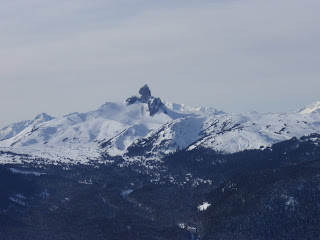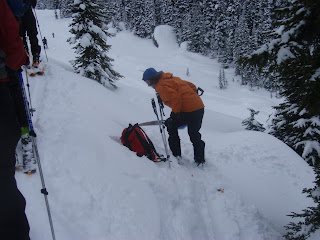
Over the last two weekends Mike and I have been taking our Avalanche Skills Training - Level 2 (AST2) with Canada West Mountain School (CWMS). About 5 years ago we took the level one course where we learned how to recognize avalanche terrain, how to use our beacons and perform searches and how to do basic snow stability (compression) tests. Since then we have been playing out in the backcountry with experienced skiers to practice our skills and learn more about traveling safely in the mountains in the winter.

We figured it was time, after relying on the knowledge of others for decision making the past few years, to take the next level of formalized training to increase our knowledge and level of safety in the backcountry and to become more self-sufficient when it comes to making smart decisions in avalanche terrain. AST2 is the next level of training provided and builds directly on the Level 1 course we took 5 years ago.

The ACC set up our course with CWMS so we had a private course of just ACC members at a discounted rate (Thanks ACC!). We ended up with a great group of 8 of us who were all excited and eager to learn more about travelling safely in the backcountry. It made for interesting and thoughtful questions and discussions throughout the course and made for an excellent and supportive learning environment. The group took a couple days to get to know each other and had to put in some effort to travel efficiently together, but it all worked out by the last day and was a great experience to learn how to work with the "people" aspect and group dynamics of backcountry travel.

Our guide's name for the 4-days was Bruce Wilson, a guide who works privately as well as for CWMS. He also teaches at Capilano University. He was a very knowledgeable and patient instructor who was happy to answer any questions and to tailor our course to the groups preferences so we would get the most out of our time. I quite enjoyed learning from him and would happily do further course or trips with him in the future.

On day one of our course we spent half of the day in a classroom, learning about avalanche terrain and snow stability. After lunch we headed out to Mt Seymour to get a taste of digging a snow pit, doing a snow profile and performing stability tests on the snow. That night we were left with the homework of determining the weather and avalanche risk in Whistler for our second day of the course so we could have a discussion on what to expect in the Whistler snowpack first thing the next morning.

Our second day of the course started with a bit of a panic. I realized that the rivet at the pivot point on my ski boot had broken the day before so we had to get to Whistler by 7am to try and either rent boots or find a repair shop. It turned out that nothing opened until 8am, but we managed to find a shop that provided a temporary fix and we met the group in the lift line by 8:20. Disaster averted.

From there we rode the lifts up to the Roundhouse where we went over the backcountry maps, Avi report and weather reports and discussed what we expected to find with regards to the snow and its stability. It was a good intro to what we should be doing prior to every trip into the backcountry. From the Roundhouse we skied out the cat track and into the musical bumps area. We had a small mishap and lost a group member along the way, but luckily we all had phones, sorted it out and reconvened at the backcountry gate. We had some excitement along the way too when we realized we were skinning up right beside Trevor Linden!

The third day of the course was spent in the Blackcomb backcountry. We rode the lifts up, had a meeting at the Glacier Lodge and headed out toward Disease Ridge. The weather was hugely variable and there was more fresh snow than expected, so it was good day for learning. We had discussions about route finding and did some quick stability tests along the way. When we go to the ridge we decided that the stability was pretty good, so we opted to work our way up the face and through some rocky terrain to work on route finding skills instead of climbing directly up the ridge. It was a great way to practice our group management and communication skills as well. Once we reached the top we traveled along the ridge to the very end where we had spied an entry point onto a steep line, just above a cornice.

With the solid snow pack we thought it may have been fun to ski the steeps, but when we got up there a wind slab on a convex roll began to crack and show signs of weakness. We dug a pit, did a snow profile, discussed our observations and decided that the signs of weakness in the snow were a red flag, so we turned back to ski some mellower terrain. We ended up skiing a line very close to where we had originally gained the ridge and then skied out the Blackcomb ski runs. We finished the day with a debrief and trip planning session for the following day's adventure and we had a relaxing night over burgers in beers with the group in a Pemberton hotel.


On the final day Bruce (our guide/instructor) acted as a facilitator and left us to organize and lead the trip for the day. We chose to ski in the Cayoosh area off the Duffy Lake Road, with our goal being a line called "Arm Chair". We all took turns leading the group and route finding while discussing our decisions and conducting stability tests along the way. The day was excellent and was a great way to pull together all that we had learned in the last few days. Discussing all of our decisions with the group was a vital part of allowing everyone to absorb information and learn some route finding and terrain risk management skills first hand.

When we reached our high point for the day, we completed a full snow profile and then started our descent. We were travelling in "challenging" terrain with gullies, cliffs and a low snow pack, combined with varying skiing abilities within the group. It made for some tense moments, but really allowed our group to work together as a team and make smart decisions to ski out safely. After we passed the challenging terrain we had some great turns in fresh pow.

Overall the course was well done and well executed. We all learned a lot and I am glad we spent the last two weekends devoting time to it. I feel the information that we learned will be integral in keeping us safe in the mountains in a winter environment for years to come.






















